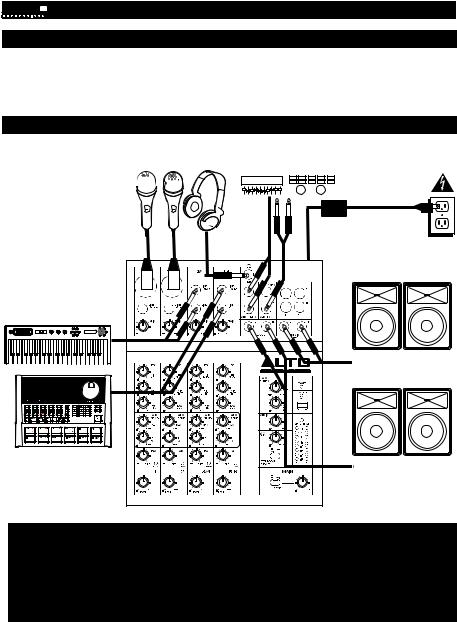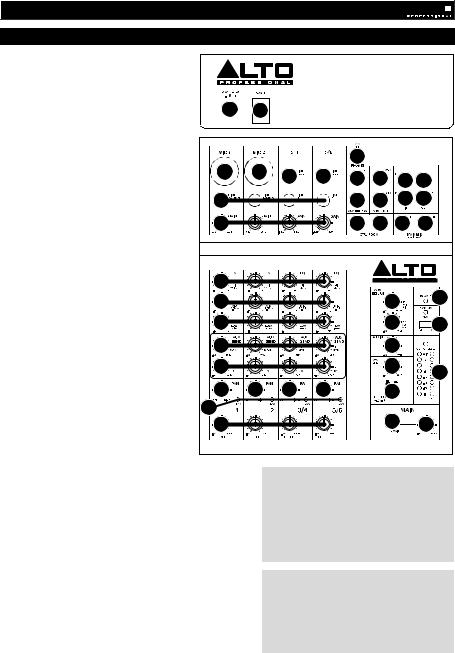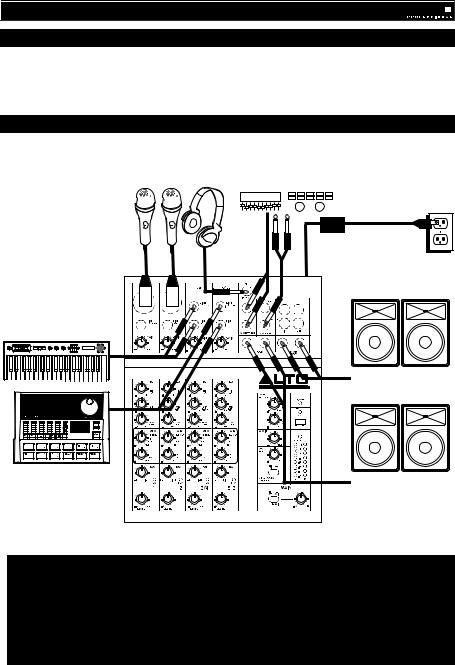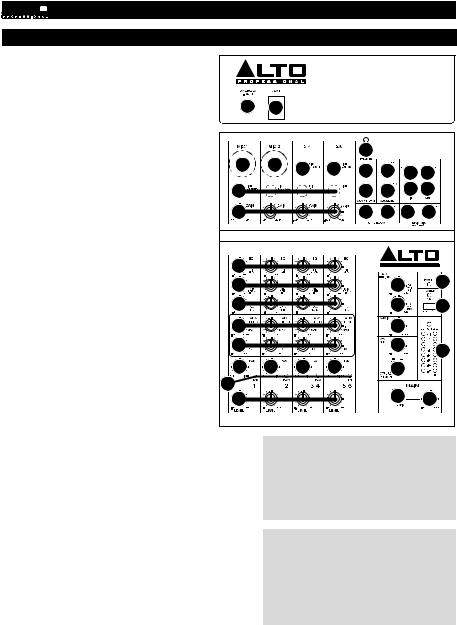Alto ZMX862 User Manual [ru]

QUICKSTART GUIDE
ENGLISH ( 2 – 4 )
MANUAL DE INICIO RÁPIDO
ESPAÑOL ( 5 – 7 )
GUIDE D’UTILISATION RAPIDE
FRANÇAIS ( 8 – 10 )
GUIDA RAPIDA
ITALIANO ( 11 – 13 )
SCHNELLSTART-ANLEITUNG
DEUTSCH ( 14 – 16 )
SNELSTARTGIDS
NEDERLANDS ( 17 – 19 )

BOX CONTENTS
yZEPHYR mixer
yPower adapter
yQuickstart Guide
ySafety Instructions & Warranty Information booklet
CONNECTION DIAGRAM
Headphones*
Microphones* 
External effects rack, compressor, etc.*
Power
Keyboard*
Drum Machine*
* not included
2 TK |
2 TK |
2 TK |
House Speakers*
Monitors*
Notes:
yMicrophones, monitors, amplifier, speakers, cables, etc. are not included.
yTo reduce electrical hum at high gain settings, keep the mixer's power supply away from your guitar cable and the mixer's channel inputs.
yTo use an external effects rack unit, compressor, etc., use a Y-cable (1/4" stereo to two 1/4" mono) to connect the AUX SEND "2 FX" output to the left and right inputs your external device. Connect the outputs of your external device to the left and right AUX RETURN INPUTS.
2

FEATURES
1. |
POWER IN – Use the included power |
|
|
|
|
|
|
|
|
|
|
adapter to connect the mixer to a |
|
|
|
|
|
|
|
|
|
|
power outlet. While the power is |
|
|
|
|
|
|
|
|
|
|
switched off, plug the power supply |
|
|
|
|
|
|
|
|
|
|
into the mixer first, then plug the power |
1 |
2 |
|
|
|
|
|
|
|
|
supply into a power outlet. |
|
|
|
|
|
|
|
||
|
|
|
|
|
|
|
|
|
|
|
2. POWER SWITCH – Turns the mixer |
|
|
|
|
|
|
|
|
||
|
on and off. Turn on the mixer after all |
|
|
|
|
|
|
|
|
|
|
input devices have been connected |
|
|
|
|
21 |
|
|
|
|
|
and before you turn on amplifiers. |
|
|
|
|
|
|
|
||
|
|
|
|
|
|
|
|
|
||
|
Turn off amplifiers before you turn off |
3 |
3 |
4 |
4 |
15 |
16 |
|
|
|
|
the mixer. |
|
|
|
17 18 |
|||||
|
|
|
|
|
|
|||||
3. |
MIC INPUT – Connect a microphone |
4 |
|
|
|
15 |
16 |
17 18 |
||
|
to these inputs with an XLR cable. |
|
|
|
|
|||||
|
|
|
|
|
|
|
|
|
2 TK |
|
|
|
|
|
|
|
|
|
|
|
|
4. LINE INPUT * – Connect line-level |
5 |
|
|
|
19 |
19 20 |
20 |
|||
|
devices to these inputs with 1/4" |
|
|
|
|
|
|
|
|
|
|
cables. |
|
|
|
|
|
|
|
|
|
5. GAIN – Adjusts the channel audio |
|
|
|
|
|
|
|
|
||
|
level (pre-fader and pre-EQ gain). |
|
|
|
|
|
|
|
|
|
|
Adjust this so that the PEAK LED just |
6 |
|
|
|
|
|
|
|
|
|
barely lights up during the loudest |
|
|
|
|
|
|
|
||
|
|
|
|
|
|
|
|
|
||
|
parts of the song. |
|
7 |
|
|
|
|
22 |
|
31 |
6. HI EQ (TREBLE) – Adjusts the high |
|
|
|
|
|
|
|
|
||
|
(treble) frequencies of the channel. |
|
8 |
|
|
|
|
23 |
|
30 |
7. MID EQ – Adjusts the mid-range |
9 |
|
|
|
|
24 |
|
|
||
|
frequencies of the channel. |
|
|
|
|
|
|
|
||
8. |
LO EQ (BASS) – Adjusts the |
low |
10 |
|
|
|
|
25 |
|
|
|
(bass) frequencies of the channel. |
|
|
|
|
|
|
29 |
||
9. |
the |
|
|
|
|
|
|
|
||
AUX SEND 1 MON – Adjusts |
11 |
11 |
12 |
12 |
|
2 TK |
|
|
||
|
channel audio (pre-EQ) level that is |
|
26 |
|
|
|||||
|
|
|
|
|
|
|
|
|
||
|
sent to the AUX SEND output labeled |
13 |
|
|
|
|
|
|
|
|
|
"1 MON." You can use this to create a |
14 |
|
|
|
|
27 |
|
28 |
|
|
custom monitor mix for yourself or |
|
|
|
|
|
||||
|
|
|
|
|
|
|
||||
|
|
|
|
|
|
2 TK |
|
|
||
|
your musicians. |
|
|
|
|
|
|
|
|
|
10.AUX SEND 2 FX – Adjusts the
channel audio (post-EQ) level that is sent to the
|
mixer's internal effects processor. Turn this up for the |
* When using LINE INPUTS 3/4, 5/6 and the |
|
channels that you want internal effects applied to. |
AUX RETURNS: |
|
You can use this to apply external effects to individual |
• If only the left channel is used, the signal |
|
channels. |
will be heard in both left and right |
11. |
CHANNEL PAN – Adjusts the (mono) channel's |
channels and the balance will not be |
|
position in the stereo field. |
adjustable. |
12. |
BALANCE (CH 3/4 & 5/6) – Adjusts the balance |
• If only the right channel is used, the signal |
|
between Channels 3 and 4 and Channels 5 and 6. |
will be heard in the right channel only. |
|
|
13.PEAK LED – The LED will flash if the signal is
clipping. If this happens, decrease the setting of the |
** To use an external effects rack unit, |
|
GAIN knob or CHANNEL VOLUME knob. |
compressor, etc., use a Y-cable (1/4" stereo |
|
14. CHANNEL VOLUME – Adjusts the audio level on the |
to two 1/4" mono) to connect the AUX SEND |
|
"2 FX" output to the left and right inputs your |
||
channel. |
||
external device. Connect the outputs of your |
||
15. AUX RETURN INPUTS ** – You can connect the |
||
external device to the left and right AUX |
||
outputs of an external device to these inputs with 1/4" |
RETURN INPUTS. |
|
mono cables. This is usually used for outboard |
|
effects devices but can also be used like an extra input channel for synthesizers, drum machines, etc. If your source is mono, plug it into the left jack and it will be heard on both the left and right sides.
16.AUX SEND OUTPUTS ** – You can use a 1/4" TRS cable to connect the AUX 1 MON output to the input of an external amplifier or active monitor to create a custom monitor mix for onstage musicians. You can adjust this level with the AUX RETURN LEVEL knob labeled "TO AUX 1 MON." To use an external effects rack unit, compressor, etc. with the mixer, you can use a Y-cable to connect the AUX 2 FX output to the input of your external device, then connect the outputs of the device to the AUX RETURN INPUTS of the mixer.
3

17.2-TRACK INPUTS – You may connect these inputs to the outputs of an external sound source using a standard stereo RCA cable (sold separately). You can send this channel to the monitor mix (using the MAIN/2-TRACK switch) and/or the main mix (using the 2-TRACK TO MAIN switch).
18.2-TRACK OUTPUTS – You may connect these outputs to the inputs of an external recording device using a standard stereo RCA cable (sold separately).
19.CTRL ROOM OUTPUTS – Use standard 1/4" cables to connect these outputs to your monitor or amplifier system. The level of these outputs is controlled by the CTRL ROOM / PHONES knob.
20.MAIN MIX OUTPUTS – Use standard 1/4" cables to connect these outputs to the house speaker or amplifier system. The level of these outputs is controlled by the MAIN VOLUME knob.
21.PHONES – Connect your 1/4" stereo headphones to this output. The CTRL ROOM / PHONES knob controls the volume.
22.AUX RETURN TO MAIN MIX – Adjusts the volume of the signal being sent into the AUX RETURN INPUTS and routed to the MAIN MIX OUTPUTS.
23.AUX RETURN TO AUX 1 MON – Adjusts the volume of the signal being sent into the AUX RETURN INPUTS and routed to the CTRL ROOM OUTPUTS.
24.2-TRACK IN LEVEL – Adjusts the input signal level of the AUX INPUTS.
25.CTRL ROOM / PHONES – Adjusts the volume of the CTRL ROOM OUTPUTS and your headphones.
26.MAIN / 2-TRACK – Press this button to select which signal is routed to the CTRL ROOM OUTPUTS and your headphones – the main mix or the signal from the 2-TRACK INPUTS.
27.2-TRACK TO MAIN – Press this button to select which signal is routed to the MAIN MIX OUTPUTS – the main mix or the signal from the 2-TRACK INPUTS.
28.MAIN VOLUME – Adjusts the volume of the MAIN OUT.
29.LED METERS – Shows the audio level of the main mix. Turn the volume down if the CLIP LED lights up excessively.
30.PHANTOM POWER – This switch activates and deactivates phantom power. When activated, phantom power supplies +48V to the XLR mic inputs and the LED above the switch will be lit. Please note that most dynamic microphones do not require phantom power, while most condenser microphones do. Consult your microphone’s documentation to find out whether it needs phantom power.
31.POWER LED – Illuminates when the mixer is on.
4

CONTENIDO DE LA CAJA
yMezclador ZEPHYR
yAdaptador de alimentación
yGuía de inicio rápido
yFolleto de instrucciones de seguridad e información sobre la garantía
DIAGRAMA DE CONEXIÓN
|
Auriculares* |
Rack de efectos, |
|
|
Micrófonos* |
compresor, etc. externo* |
Suministro |
||
|
eléctrico 
Teclado*
Caja de ritmos*
* no incluido
2 TK |
2 TK |
2 TK |
Altavoces del auditorio*
Monitores*
Notas:
yNo se incluyen micrófonos, amplificador, altavoces, cables, etc.
yPara reducir el zumbido eléctrico cuando se usan ajustes altos de ganancia, mantenga la fuente de alimentación del mezclador alejada del cable de su guitarra y de las entradas de los canales del equipo.
yPara usar una unidad de rack de efectos, compresor, etc. externos, utilice un cable en “Y” (estéreo de 1/4"a dos mono de 1/4") para conectar la salida de ENVÍO AUXILIAR "2 FX" a las entradas izquierda y derecha de su dispositivo externo. Conecte las salidas de su dispositivo externo a las
5

CARACTERÍSTICAS
1.ENTRADA DE ALIMENTACIÓN - Use el adaptador de alimentación incluido para conectar el mezclador a un tomacorriente alimentado. Con la alimentación eléctrica desconectada, enchufe la fuente de alimentación al mezclador primero, y luego al tomacorriente.
2.INTERRUPTOR DE ENCENDIDO –
Enciende y apaga el mezclador. Encienda el mezclador después de desconectar todos los dispositivos de entrada y antes de encender los amplificadores. Apague los amplificadores antes de apagar el mezclador.
3.ENTRADA DE MICRÓFONO – Conecte a estas entradas un micrófono con un cable XLR.
4.ENTRADA DE LÍNEA * – Conecte a estas entradas dispositivos de nivel de línea con cables de 1/4”.
5.GANANCIA - Ajusta el nivel de ganancia de audio del canal (preecualización y prefader). Ajuste este control de modo que el LED PEAK apenas se encienda durante las partes más sonoras del tema.
6.ECUALIZACIÓN DE ALTOS (AGUDOS) –
Ajusta las altas frecuencias (agudos) del canal.
7.ECUALIZACIÓN DE MEDIOS – Ajusta las frecuencias medias del canal.
8.ECUALIZACIÓN DE BAJOS (GRAVES) –
Ajusta las bajas frecuencias (graves) del canal.
1 |
2 |
|
|
|
|
|
|
|
|
|
|
21 |
|
|
|
3 |
3 |
4 |
4 |
15 |
16 |
|
|
|
|
17 18 |
|||||
|
|
|
|
||||
4 |
|
|
|
15 |
16 |
17 18 |
|
|
|
|
|
|
|
|
2 TK |
5 |
|
|
|
19 |
19 |
20 |
20 |
6 |
|
|
|
|
|
|
|
7 |
|
|
|
|
22 |
31 |
|
|
|
|
|
|
|||
8 |
|
|
|
|
23 |
30 |
|
|
|
|
|
|
|
|
|
9 |
|
|
|
|
24 |
|
|
10 |
|
|
|
|
25 |
29 |
|
|
|
|
|
|
|
|
|
11 |
11 |
12 |
12 |
|
|
2 TK |
|
|
26 |
|
|||||
13 |
|
|
|
|
|
|
|
14 |
|
|
|
|
27 |
28 |
|
|
|
|
|
|
|
||
|
|
|
|
|
2 TK |
|
|
9.ENVÍO AUXILIAR 1 MON – Ajusta el nivel de audio del canal (pre-ecualización) que se envía a la salida de ENVÍO AUXILIAR rotulada “1 MON”. Puede usarlo para crear una mezcla de monitor personalizada para usted mismo o para sus músicos.
10.ENVÍO AUXILIAR 2 FX – Ajusta el nivel de audio del canal (post-ecualización) que se envía al procesador de efectos interno del mezclador. Aumente el ajuste para los canales a los que desea aplicar efectos internos. Puede usarlo para aplicar efectos externos a canales individuales.
11.PANEO DE CANAL – Ajusta la posición del canal (mono) en el campo estéreo.
12.BALANCE (CANALES 3/4 Y 5/6) – Ajusta el balance entre los canales 3 y 4 y los canales 5 y 6.
13.LED DE PICO – El LED destella si la señal se está recortando. Si esto sucede, disminuya el ajuste de la perilla GAIN o la perilla de volumen CHANNEL (Canal).
*Cuando use las ENTRADAS DE LÍNEA 3/4, 5/6 y los RETORNOS AUXILIARES:
•Si sólo se usa el canal izquierdo, la señal se oirá en los canales izquierdo y derecho y no se puede ajustar el balance.
•Si sólo se usa el canal derecho, la señal se oirá sólo en ese canal.
** Para usar una unidad de rack de efectos, compresor, etc. externos, utilice un cable en “Y” (estéreo de 1/4"a dos mono de 1/4") para conectar la salida de ENVÍO AUXILIAR "2 FX" a las entradas izquierda y derecha de su dispositivo externo. Conecte las salidas de su dispositivo externo a las ENTRADAS DE RETORNO AUXILIAR izquierda y derecha.
14.VOLUMEN DE CANAL – Ajusta el nivel de audio del canal.
15.ENTRADAS DE RETORNO AUXILIAR ** – Puede conectar a estas entradas las salidas de un dispositivo externo con cables mono de 1/4". Esta entrada se usa habitualmente para dispositivos de efectos externos pero también se puede usar como canal de entrada adicional para sintetizadores, cajas de ritmo, etc. Si su fuente es mono, enchúfela en el conector izquierdo y se escuchará en ambos lados, izquierdo y derecho.
6
